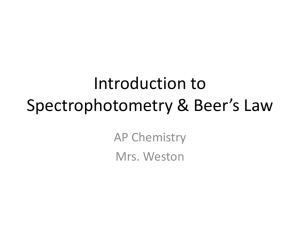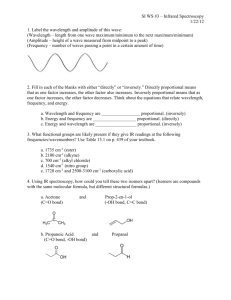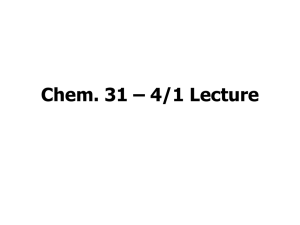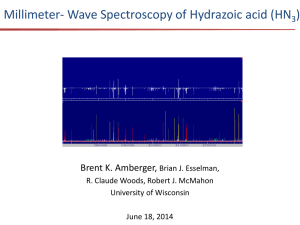Advanced Molecular Spectrsocopy – CHEM 5591
advertisement
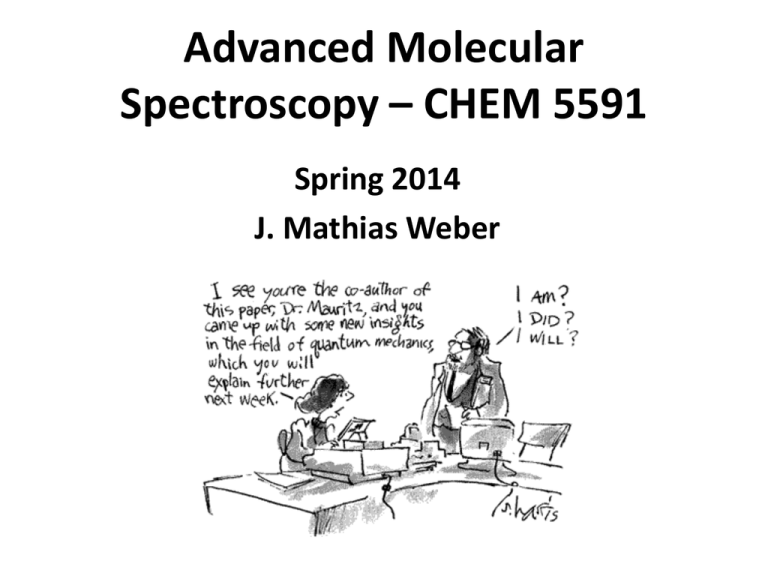
Advanced Molecular Spectroscopy – CHEM 5591 Spring 2014 J. Mathias Weber Technicalities(1) • Requirements: – two semesters of undergraduate physical chemistry and graduate standing – recommended: firm grasp of algebra, complex numbers, calculus, differential equations, CHEM 5581 • Class hours: MWF 09:00 am to 09:50 am • Office Hours: M, T: 4 pm – 5 pm DOES THIS WORK FOR EVERYONE ? Technicalities(2) • Locations: – JILA tower A709 – phone 492-7841 – email weberjm@jila.colorado.edu – web site: http://jila.colorado.edu/weberlabs/course-CHEM5591.html • Exam schedule: – Two-hour exams: Feb 18, April 1 6-8 pm, locations TBA – Final Exam: date, time, and location TBA DOES THIS WORK FOR EVERYONE ? Technicalities(3) • Problem sets (homework): – usually handed out (i.e. posted on course web site) on Wednesdays, to be returned the following Wednesdays before class – homework will be graded by graduate student Ben Knurr. – credits accumulated over the semester determine your homework performance grade. Everyone may drop one homework assignment without penalty. – worked solutions to problem sets will be posted on the course web page. • Travel: Due to professional travel, there will be no class meetings on Feb. 26, Feb. 28, April 28, April 30 and May 2. The lectures will be given on other dates instead. I will set up a doodle poll to find an appropriate day in the week. It may have to be Saturday afternoons …. Technicalities(4) • Grades: – homework performance: 40% – clicker questions (participation) 5% – average of the two-hour-exams: 30% – final exam: 25% • All slides and clicker questions will be posted on the course web page Literature: • Wolfgang Demtröder “Molecular Physics” (main text book for the course). • Wolfgang Demtröder “Laser Spectroscopy” (useful resource) • H. Haken, H. C. Wolf “Molecular Physics and Elements of Quantum Chemistry” (useful resource) • G. Herzberg “Molecular Spectra & Molecular Structure” (the spectroscopy “bible”) • Browse the library or the book store for other books that you may like... Goals of Spectroscopy: • Experimental determination of the properties of the quantum states of a system (atoms/molecules/materials). Theoretical prediction of these properties. • Study of transition probabilities between these states • Understanding of dynamic problems (e.g. dissociation, radiationless transitions, excited state lifetimes, electron emission, ...) Approaches: How do we get such data? Interaction of a sample with • Light: o absorption o emission o scattering • Matter particles o electrons o neutrons o atoms o molecules o ... Method typical spectral range degree of freedom NMR 107 – 109 Hz nuclear spin 3·10-4 – 3·10-2 cm-1 EPR 109 – 1011 Hz electron spin 3·10-2 – 3 cm-1 microwave spectroscopy 109 – 1011 Hz mol. rotation 3·10-2 – 3 cm-1 infrared spectroscopy 1011 – 1014 Hz mol. vibrations 3 – 3·103 cm-1 UV/vis spectroscopy 1014 – 1016 Hz valence electrons 3·103 – 3·105 cm-1 X-ray spectroscopy > 1016 Hz > 3·105 cm-1 core electrons Typical energies: • ionization potentials 5 – 15 eV (40 – 121·103 cm-1) • electron affinities 0 – 4 eV (0 – 32·103 cm-1) • dissociation energies 1 – 5 eV (0 – 32·103 cm-1) • vibrations 0.1 - 0.5 eV (800 – 4000 cm-1) • rotations 10 meV – 1 meV (0.08 – 8 cm-1) The color of a nonfluorescent object is due to the light left after absorption 0.6 0.5 Na2Cr2O7 K2IrBr6 0.3 0.2 0.4 Cu(NO3)2 absorbance absorbance 0.4 absorbance 0.15 0.2 0.10 0.05 0.1 0.0 300 0.0 400 500 600 wavelength [nm] 700 800 300 0.00 400 500 600 wavelength [nm] 700 800 300 400 500 600 wavelength [nm] 700 800 The color of a nonfluorescent object is due to the light left after absorption 0.6 0.5 Na2Cr2O7 K2IrBr6 0.3 0.2 Cu(NO3)2 0.4 absorbance absorbance 0.4 absorbance 0.15 0.2 0.10 0.05 0.1 0.0 300 0.0 400 500 600 700 800 400 500 600 700 800 wavelength [nm] wavelength [nm] perceived absorbed 300 0.00 300 400 500 600 700 wavelength [nm] absorbed perceived absorbed perceived 800


